What you need is use a Timer which changes the state of your component ( in this case the cellular growth ) and then call JComponent.repaint()
This timer can be cancelled to make the pause and then to restart it, you just create a new one:
So you could define the following two methods:
private Timer timer;
...
public void startPaiting() {
timer = new Timer();
timer.schedule( new TimerTask(){
public void run(){
changeState();
repaint();
}
},0, 10000 ); // 10 s.
}
public void pause(){
timer.cancel();
}
And then in your "Pause/Resume" button invoke this "pause/startPaiting" methods:
if( e.getActionCommand().equals("Pause")){
growPanel.pause();
setText("Resume");
} else {
growPanel.startPaiting();
setText("Pause");
}

Here's the complete source code to see it running:
import javax.swing.*;
import java.awt.Graphics;
import java.awt.Point;
import java.awt.event.*;
import java.util.Timer;
import java.util.TimerTask;
public class Grow {
public static void main( String [] args ) {
JFrame frame = new JFrame();
final GrowPanel growPanel = new GrowPanel();
frame.add( growPanel );
frame.add( new JPanel(){{
add( new JButton("Pause"){{
addActionListener( new ActionListener(){
public void actionPerformed( ActionEvent e ){
if( e.getActionCommand().equals("Pause")){
growPanel.pause();
setText("Resume");
} else {
growPanel.startPaiting();
setText("Pause");
}
}
});
}});}}, java.awt.BorderLayout.SOUTH );
frame.setSize( 400, 300 );
frame.setVisible( true );
}
}
class GrowPanel extends JComponent {
private int x;
private int y;
private Timer timer;
GrowPanel() {
x = 10;
y = 10;
startPaiting();
}
public void startPaiting() {
timer = new Timer();
timer.schedule( new TimerTask(){
public void run(){
changeState();
repaint();
}
},0, 100 ); // or 10000 which is 10 s.
}
public void pause(){
timer.cancel();
}
public void paintComponent( Graphics g ){
g.fillOval( x, y, 10, 10 );
}
private void changeState(){
x+=10;
if( x >= 400 ) {
y+=10;
x = 0;
}
if( y >= 300 ){
y = 10;
}
}
}
